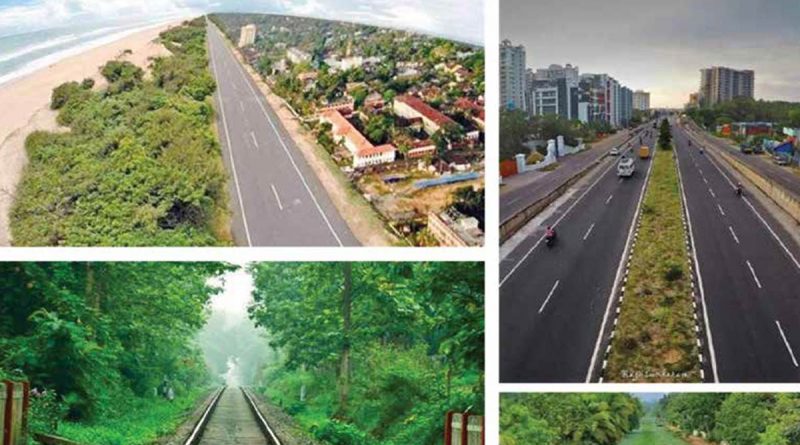Seamless Infrastructure

Dr. Manoj KUMAR K.
Infrastructure is defined as the physical framework that derives fundamental facilities and systems that assists the sustainable functionality, providing support to economy for faster growth and alleviation. Viewing Tourism as a national asset, shaping of infrastructure indicates development for the host alongside the visitors.
Tourism and hospitality is the prime revenuegenerating sector in most countries around the world and more so in a developing country like India. India offers geographical diversity, world heritage sites and niche tourism products like cruises, adventure, medical, eco-tourism and thereby a truly experiential and exotic experience to its visitors worldwide.
As for Kerala, the southernmost tip of the subcontinent, which has also been named one of the ten paradises of the world by ‘National Geographic Traveller’, tourism had developed as an important sector by the late 1980s. By the early 2000s, Kerala was able to garner a full-fledged flourishing industry via tourism. Kerala marked its position for being a tropical haven in India; the bounties of nature that included geographical and ecological peculiarities added to its value as a tourist hub, especially since it has taken the role of a gateway to many other tropical destinations like Lakshadweep, Andaman, Male etc. Today, growing at a rate of 13.31%, Kerala is one of the most visited tourism destinations in  India.
India.
Kerala is abundantly blessed with waterbodies including canals, lakes that form extensive backwater channels all through the state on one side, and the allembracing coastline on the other side. The magnificent mountain ranges and hilltops are an equally popular feature of Kerala with its rich granaries of indigenous flora and fauna. An important feature of Kerala that remarkably sets it apart is the fact that there is so much versatility in terms of terrains and natural experiences across very short distances. This vivid variety in its natural aspects has aptly been honoured by the name ‘God’s Own Country’.
While this is an important reason why tourism flourished in Kerala, there is also a need to mention the heritage of Kerala which has also immensely contributed to it. Apart from its natural heritage, the State is sought for its cultural and built heritage. Courtesy of its very dynamic history, Kerala has a lot of stories and legacies to showcase.
Be it the ones of the exuberant trade that decked the shores of the state, or the ones of the struggles and revolutions that changed the image of society in Kerala. These are quite evidently marked by the plethora of built heritage and traditional knowledge that are still lying untapped in various parts of the state.
Kerala marked its position for being a tropical haven in India; the bounties of nature that included geographical and ecological peculiarities added to its value as a tourist hub, especially since it has taken the role of a gateway to many other tropical destinations like Lakshadweep, Andaman, Male etc.
While flourishing tourism itself ensures an overall improvement in addition to infrastructure, it is also a key aspect of successfully developing destinations that will draw tourists from around the globe. In addition, tourism will eventually encourage investments which will in turn help in the value addition and up scaling of the locality as well. Thereby it can be said that tourism infrastructure is an enabler for overall economic and infrastructure development.
Tourism infrastructure is a broad category that includes accommodation, event venues, parks facilities, dining and entertainment precincts; cultural and arts amenities, transport networks and interchanges; aviation, maritime and road infrastructure, and more. There are certain aspects that need to be given special attention in order to ensure a seamless experience for the visitors.
Since tourism mostly deals with the experiences one gains from travel destinations, the core idea is to identify tourism projects, areas of investment, and types of investments, etc, to develop the destination. Tourism Infrastructure will have to cater to destination development and maintenance as well as experience building for the visitors. This can be achieved by facilitating smooth travel options, better accessibility, and promotion of tourism products like Kettuvallam, Caravans, Uru, etc., that can deliver an assortment of experiences to the visitors.
The future of tourism in Kerala will be marked by a newly devised scheme to enhance the existing entities by taking advantage of the linear structure of Kerala. To achieve this, the various visual corridors of Kerala will be delineated, focusing on the existing north-south movement networks primarily facilitated by the linear structure of the state. Visual corridors will be designed with state-of-the-art facilities that provide unique experiences to tourists. The corridors will be focusing on different aspects like the coastline, water bodies, cultural heritage, built heritage, etc.
Coastal Highway Corridor, National/State Highway Corridor, Rail Corridor, Water Corridor (Canal, Lake etc.), Hill Way Corridor, etc., are some of the proposed corridors. These corridors will run parallel in the north-south direction with intermittent tourism nodes connecting laterally in the eastwest direction. These nodes will include tourism facilitation services like amenity centres, interpretation centres, fuel stations, motels, etc., which will act as tourism hubs. This sort of approach would work in favour of the state as it has a lot of untouched potential and prospects that are waiting to be discovered. Since this mode promotes an exploratory approach, it is imperative that more opportunities are identified and taken advantage successfully.


